 Many school choice enthusiasts think school choice legislation can be passed if only a number of minority political leaders can be won to the cause. Polls show that African Americans are among the strongest supporters of vouchers, tax credits, and charter schools (see “What Americans Think about Their Schools,” features, Fall 2007). If minority leaders can be weaned away from traditional alliances, the underlying public support will translate into effective legislative action, especially if choice laws focus on schools in urban areas.
Many school choice enthusiasts think school choice legislation can be passed if only a number of minority political leaders can be won to the cause. Polls show that African Americans are among the strongest supporters of vouchers, tax credits, and charter schools (see “What Americans Think about Their Schools,” features, Fall 2007). If minority leaders can be weaned away from traditional alliances, the underlying public support will translate into effective legislative action, especially if choice laws focus on schools in urban areas.
All of that sounds convincing in theory, but the reality can be quite different. In state after state, when legislators introduce proposals aimed at moving students out of failing schools, activists emerge to delay, block, or sabotage the plans. The legislative history of the 2005 and 2006 tuition grant proposals in the Missouri House of Representatives offers some insights into how complex the political game can become, even when support from minority legislators is substantial.
The Missouri plan was designed to avoid the controversial label “school voucher.” Rather than reallocating dollars slated for education, supporters proposed to give tax credits to individuals and businesses that donated money to nonprofit organizations providing low-income students with scholarship grants to attend private schools (see Table 1). Described this way, the legislation had the initial support of a broad coalition of Republicans and Democrats, blacks and whites. Not surprisingly, the teachers unions mounted a vigorous campaign against the bill. Under that pressure, the tuition grant coalition fell apart during the legislative process, revealing sharp divisions within the ranks of blacks and Republicans.
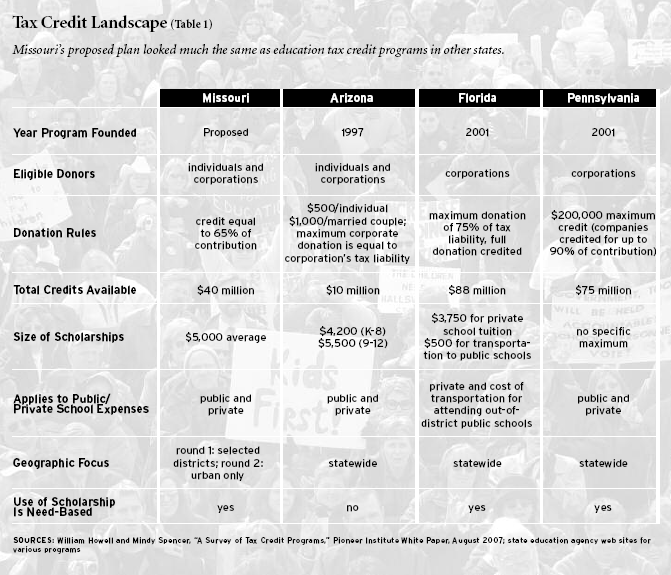
The Battleground
As elsewhere, school reform in Missouri takes place amid racially polarized municipal politics. School budget crises are continuous, teachers union leadership is combative, and minority community involvement is generally ineffective. Although the legislative maneuvering took place in Jefferson City, the state capital, the real audience for the tuition grant debate was the city of St. Louis.
The politics of the St. Louis schools is a black community affair. Many of the current school leaders were in the forefront of efforts to desegregate the schools beginning in the 1970s. Jim Buford, president of the St. Louis Urban League and founder of the Black Leadership Roundtable, explained, “public schools are engrained into the fabric of the community.” African Americans represent about half of the city’s population, and 81 percent of the public school enrollment. About 80 percent of St. Louis students are in the free and reduced-price school lunch program. Unfortunately, the quality of the schools declined sharply after their peak 1983 AAA state rating; the dropout rate is high and student achievement low. By 2005, the district was only partially accredited, a serious situation with no clear solution at hand.
St. Louis has a strong public school cartel, an alliance of teachers union leaders, central board administrators, and various public-school interest groups that has an established routine for managing the schools and is typically skeptical of any proposal for change. The cartel acts as a veto player in school policymaking. Members are linked by churches, social organizations, and school ties, and these personal and political relationships drive the group’s success. Political scientist Marion Orr refers to such connections as “bonds of personalism.”
The city’s print media—including the St. Louis Post-Dispatch, which enjoys a national reputation—monitor the black leadership class and report on its interaction with the school system. St. Louis also has three African American weeklies that are widely read by both black opinion leaders and the public. Dr. Donald Suggs, a dentist and school supporter, owns the award-winning St. Louis American, which claims a readership of 90,000. His annual “Salute to Excellence” dinner attracts most of the players in school politics.
Given this rich tradition of an attentive and large black middle class, why has the St. Louis school district been so dysfunctional? St. Louis has a weak mayoral form of government. Although the mayor appoints directors of city departments, he shares budgetary powers with an elected comptroller and the Board of Aldermen. The mayor, comptroller, and president of the Board of Aldermen are members of the Board of Estimate and Apportionment, which approves the city’s annual operating budget, appropriations, and all city real-estate purchases. Hence the mayor must expend considerable energy and political capital to get other elected city officials to agree on policy. The elected school board is part of this fragmentation. Attempts to reform this Rube Goldberg system repeatedly failed.
Round 1: Learning the Ropes
In 2003, the St. Louis school district, designed for 80,000 students, enrolled only about 40,000. With fewer students, the district received less state aid, but since communities do not want to see their neighborhood schools shut down, the district had good political reasons to keep as many schools in operation as possible. That year, Mayor Francis Slay supported a winning slate of reform-minded candidates for the school board. Among them was Darnetta Clinkscale, a hospital administrator who had been active in the Black Leadership Roundtable. Later, Slay would appoint Jim Buford to fill a vacancy on the board. Facing an estimated $10 million deficit, the school board turned to the private sector for help. It hired the New York City consulting agency of Alvarez & Marsal, which specializes in turning around failing businesses, to get its fiscal house in order. The firm sent Bill Roberti, who became interim superintendent of the district. He quickly discovered that the deficit was actually $90 million.
To move the district toward financial stability, Roberti closed 16 schools and laid off 14,000 employees, 200 of whom were central office personnel, critical players in the school cartel. Roberti and his staff held no town meetings to explain the situation and took action without trying to console the school cartel or the public. In an interview, Buford suggested that they lacked “diplomacy.”
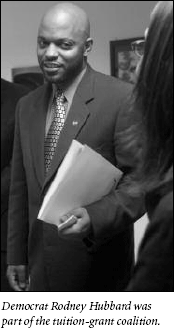
The public school cartel was still reeling when in February 2005 state representatives Ted Hoskins and Rodney Hubbard, both Democrats, and Republican Jane Cunningham introduced a bill in the Missouri House of Representatives to offer scholarships to public school students to attend parochial and private schools. Under the proposal, businesses and individuals could receive tax credits for donating money to nonprofit educational assistance organizations. These organizations could then make tuition grants ranging from $3,800 to $6,500 to eligible students. Public schools judged to be high performing would be eligible for money for textbooks, supplies, and transportation. Other funds would be available for after-school tutoring, GED programs, and apprenticeships. The proposal was named the Betty L. Thompson Scholarship Program after a well-known former black female legislator who had proposed a similar scheme in her final legislative session. The plan covered Kansas City, St. Louis, Wellston, and 13 other districts, several of them rural.
The proposal came at a time when Republicans controlled the state legislature and the governor’s office. The initial tuition grant coalition, dubbed the HHC after Hoskins, Hubbard, and Cunningham, was unique because it had a bipartisan face with support from both Republicans and some urban black Democrats. But among those in opposition were minority Democratic leaders, including key members of the Education Committee. To bypass the Education Committee, chaired by Cunningham, the coalition held hearings for the proposal in Hoskins’s Special Committee on Urban Issues, the only House committee chaired by a Democrat.
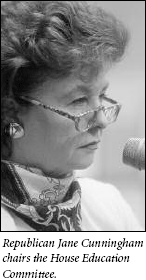
The public school cartel was appropriately alarmed. At first glance, the pilot proposal seemed small and innocuous in light of the millions of dollars Missouri spends on K–12 education. But a close examination revealed that districts would lose the state aid tied to those students who received the scholarships and left the public schools. Opponents viewed the proposal as the proverbial camel (vouchers) trying to get his nose under the tent. For them, the entire state school funding formula was at stake.
Advocates and opponents quickly emerged. Disagreement within the black community became apparent. At first, the St. Louis American attempted to be even-handed about the proposal. On the paper’s op-ed page, Jim Buford sought to reassure readers that the proposal had merit and could help the city reform its schools. Otto Fajen, the legislative director of the Missouri National Education Association (MNEA), presented the opposing view. He called the bill “tax credit vouchers” and warned that “voucher proponents seek to mislead legislators and the public regarding the true nature of this tax credit voucher by labeling it a scholarship charity.”
The characterization of the tuition grant as a “voucher” posed a public relations challenge for the sponsors, immediately putting them on the defensive. A typical voucher plan redirects per-student funding from the public schools to private schools chosen by parents and students; opposition is often vehement and backed by teachers unions. During the committee hearing, Rep. Hoskins repeatedly corrected witnesses who referred to the “voucher” bill. Nevertheless, the word voucher, with all its privatization connotations, dominated the discourse.
The public school cartel strongly opposed House Bill 639, as did the MNEA, the Missouri State Teachers Association (MSTA), and the AFL-CIO. Because two leading black representatives introduced the bill, the immediate question was whether they had the support of the entire black caucus, which included 17 state representatives and 3 state senators. They did not. Caucus member and Democrat from St. Louis Rep. Maria Chapelle-Nadal emerged as a leading opponent. She lobbied her colleagues to oppose the bill. Internecine conflicts are not uncommon in the caucus, but it was rare for members to openly campaign against a bill sponsored by a caucus member.
Opponents decided to “load up” the bill with what Jane Cunningham called “killer amendments,” which threatened to increase the cost of the program from the estimated $40 million price tag of the tax credits to $226 million. One amendment stated that the bill could not reduce state funding for education. Additional amendments required private school students to take the state’s standardized tests and the state to fully fund its school aid formula before implementing the scholarship program. To stop each of the amendments HHC needed 82 votes out of a possible 163. They got only 73 votes against the three amendments. Of the 16 African Americans in the Missouri House of Representatives, 13 voted in support of the first amendment and 9 voted for each of the others. Rep. Hoskins and his colleagues decided not to bring the bill up for a vote on the floor.
Yet the tuition grant coalition still had hope. The HHC had moved House Bill 639 further than any previous proposal to set up tax credits for scholarship donations; no prior proposal had made it to a floor debate in either the House or Senate. Also, the HHC believed it had garnered 73 solid supporters based on the amendment votes and decided to regroup and focus on how to get the additional 9 votes necessary for passage.
Round 2: Eliminating the Rural Districts
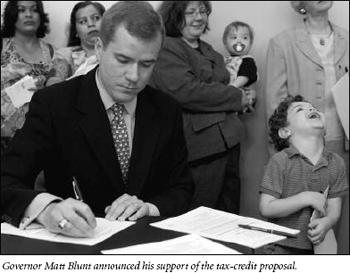
During the summer of 2005, the HHC met with Republican leaders in the Missouri House, business leaders, and Governor Matt Blunt. The governor announced during an August press conference his support of a renewed effort to pass the proposal. Reflecting on their experience during Round 1, the coalition decided rural areas liked their local schools too much to want to embrace the tax-credit idea. It would be better, they concluded, to focus on schools in the central cities, with their highly visible social problems.
Accordingly, Hoskins and Hubbard introduced House Bill 1479 with Cunningham to establish the Angell Scholarship Program and House Bill 1783 with Speaker Pro Tempore Carl Bearden (R–St. Charles) to establish the Missouri Student Success Scholarships Tax Credit Program. The two similar bills were merged in committee. Once again the proposal was named the Betty L. Thompson Scholarship Program, but this time they eliminated the rural districts in hopes of getting the additional nine votes, the strategy used by the successful charter school coalition, according to Rep. Hoskins. Coverage was narrowed to only three districts: St. Louis, Kansas City, and Wellston, potentially reaching about 8,000 poor and at-risk students in failing schools.
Nevertheless, opposition remained vigorous. Many on both sides turned up for the debate in the House Special Committee on Urban Issues. Among supporters were the speaker of the house, the lieutenant governor, and the St. Louis Regional Chamber and Growth Association. Even the mayor of St. Louis sent word of his support for the proposal, given his district’s partial accreditation. Opponents included the St. Louis and Kansas City school districts, MSTA, MNEA, the AFL-CIO, the St. Louis Teachers Local 420, and a number of key Democratic state senators.
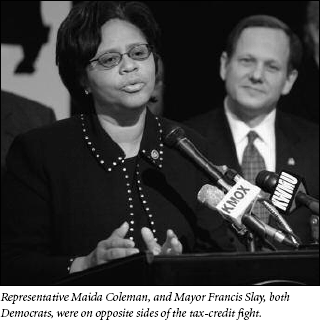
In an early round of verbal volleying, Rep. Hoskins declared, “The system has collapsed in the city of St. Louis, Kansas City and Wellston.” Sen. Maida Coleman (D–St. Louis) countered, “St. Louis Public Schools does as good as it can with what it has been given to work with.” Soon the rhetoric turned personal. Hubbard accused the bill’s opponents of being insufficiently sympathetic to the plight of urban children. Mary Washington, head of Local 420, responded that Hubbard had run away from the St. Louis schools when as a student he used the voluntary desegregation program to transfer to the Mehlville school district. Another opponent accused the bill’s supporters of being beholden to pro-voucher campaign donors.
AFT Local 420 mounted a full-blown campaign against the revised proposal, organizing a bus tour that traveled across the state. Campaign staff created cartoons and handed out leaflets to people on the street. Local 420 asked fellow unionists across the state to oppose the bill and lobbied rural school-board members to contact their state representatives. Rural board members and their superintendents became convinced their state aid and their traditions could be ground up by the gears of change.
Meanwhile, in the spring 2006 St. Louis school board campaign, the corporate community raised $500,000 to elect James Buford and reelect Darnetta Clinkscale. The AFT Local 420 acted as the vanguard for the opposition. Goaded by the laid-off school employees, anti-Roberti factions defeated Buford and Clinkscale, despite committing only $80,000 to the campaign. That upset victory was a watershed in the city’s school-board election politics and emboldened AFT Local 420 as it prepared to fight the pending tuition grant bill.
On April 12, 2006, a group of 200 parents and children, organized by school choice advocate Donayle Whitmore-Smith and Bertha Gilkey Bonds of the Black Alliance for Educational Options, traveled to the state house to lobby representatives for the bill. Parents and students, chanting “choice, choice, choice,” demanded to speak to their representatives. The St. Louis Post-Dispatch reported that Hoskins had exhorted the group to “go to the eight or nine black representatives and kick their butts.” According to Whitmore-Smith, “They did not want to separate into smaller groups. They wanted to stick together and go from office to office.” Although the group had e-mailed members and sent out press releases, they were not welcome in some of the offices of black representatives. There were some heated exchanges. The capitol police intervened when the group tried to enter Rep. Connie Johnson’s office.
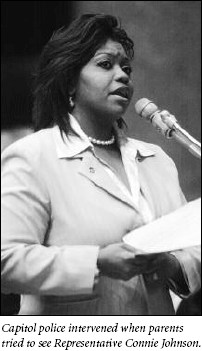
The next day the caucus had an emergency meeting. Hubbard heard “whispers about [the Caucus] kicking us out.” Hoskins thought the meeting illegal because it violated caucus rules, which require 50 percent of members to sign a notice if the chair did not call the meeting. The caucus nonetheless voted 11–3 to remove Hoskins as chair. Vice Chairman Hubbard then resigned. The bill’s sponsors continued to search in vain for the necessary votes to pass the program in the House.
After the 2006 defeat, a new lobbying effort was organized by All Children Matter (ACM). In late 2006, Hubbard and Hoskins adopted the tactics of their opponents, touring the state trying to sell the idea of school choice in rural communities. The plan backfired. When Republican leaders brought the proposal up again in March 2007, 35 Republicans voted against the bill; 26 of them were from rural districts.
Cartel Politics
Many factors contributed to the proponents’ failure to pass tuition grant legislation, among them the inclusion of rural districts in the first version of the bill. The opponents’ success in framing the debate and effective use of proven campaign tactics were decisive. Opponents of the bill understood that if they wanted to win the framing contest, they had to discredit both the message and the messengers. In public school debates, teachers often let union leaders serve as their surrogates and speak for them. Union leaders steered the debate away from the academic records of two big city school systems. They presented their own “5-Point Plan,” which shifted blame for school failure away from classroom teachers and onto a lack of funding. The union leaders termed the tuition grant proposal a “voucher bill,” and the president of AFT Local 420 questioned Rep. Hubbard’s loyalty to the St. Louis schools. Another union strategy was to insinuate that there were sinister elements working behind the HHC and in so doing nurture the conspiracy theorists within the black community.
Ultimately, the political success of a coalition depends on the ability of members to convince nonmembers that their proposal would benefit their constituency without harming other groups. Any coalition that seeks to reduce or change the formula for state aid to schools will encounter formidable opposition, as some party is likely to lose more than it gains. As the tuition grant proposal was aimed primarily at improving education for poor black children, the black-led coalition could not avoid being accused of promoting urban black interests at the expense of rural and suburban areas. At the same time, disagreements within the black community on the merits of school choice became readily apparent.
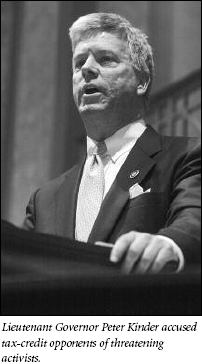
Opponents of the proposal invested considerable time and resources and even resorted to intimidating undecided school activists. Lieutenant Governor Peter Kinder remarked, “They can threaten local candidates. They demand blind adherence to their agenda. The slightest deviation will be punished. Any experimentation with new approaches will not be tolerated.” WGNU radio talk show host Liz Brown railed against the idea of tuition grants and the Buford and Clinkscale appointments to the board. She urged her listeners to “throw the trash out.”
The print media played a critical role in the debate. The Post-Dispatch sought to identify the political winners and losers, casting the story as a power struggle within the black leadership class. The subtext was the reputation, careers, and political power of city black elected officials. Hoskins claimed that the editorial section of the St. Louis American, called “The Political Eye,” was “used to discredit us [black members of HHC].”
The dynamics of the state legislature also worked against the proposal. The ouster of Rep. Hoskins as chair of the caucus signaled to the Democratic Party and its supporters that caucus members were foursquare against school choice. The Progressive Caucus, made up of Representatives Hubbard, Hoskins, Maria Chapelle-Nadal, and Connie Johnson, has since split from the black caucus. Chapelle-Nadal and Johnson are not supporting school choice; defection is their response to the leadership of the black caucus. In the Missouri House of Representatives, Hoskins now chairs the Special Committee on Urban Education Reform.
While the confrontation between parents and legislators at the state house laid bare the split within the Missouri Legislative Black Caucus, it may have been the split in Republican ranks that doomed the bill. The tuition grant coalition began with black and white co-leadership, with Republican Jane Cunningham taking a more public role. As the process evolved, it became a black-led coalition. The decision to feature the two black legislators, Hubbard and Hoskins, was a political one. Republican state lawmakers could shield themselves from the controversy by taking a relatively passive stance. The Republicans apparently did not want to give the impression that they supported a change in the school funding formula. After Republican legislators began receiving letters from their constituencies, they abandoned the struggling HHC coalition altogether.
Throughout the campaign, the opposition effectively used the label “voucher bill” to win over rural superintendents and school boards. In a Show-Me Institute poll released in May 2007, 67 percent of Missouri voters and 77 percent of African Americans said they favored a law that would “give individuals and businesses a credit on either their property or state income taxes for contributions they make to education scholarships that help parents send their children to a school of their choice, including public, private, and religious schools.” But only one-third of African Americans expressed support for “school vouchers.”
Teachers unions had built an alliance with rural district leaders, which held even after the rural districts were dropped from the plan. These districts have few private schools, and their leaders feared the loss of state revenue for public education. Rural Republican representatives broke from their suburban counterparts, who tended to support the bill. An alliance of suburban Republicans and a handful of Democrats was not enough to pass the legislation.
The sustained public attention to the schools did unleash unprecedented disequilibrium in St. Louis school politics. The inability of the system to improve its provisional state accreditation put the public school cartel’s grip on the district in jeopardy. Continuing poor performance and general disarray in the system enabled Mayor Slay to form an alliance with the governor to take over the schools. Even the teachers unions were unable to block state intervention. In March 2007, the state board of education voted 5–1 to revoke the accreditation of the St. Louis public school district altogether and turn district operations over to a transitional board, initially consisting of three members appointed by the governor, the mayor, and president of the Board of Alderman. Eventually, the city will be able to elect members. Governor Matt Blunt nominated Rick Sullivan, a businessman, as CEO of the St. Louis schools effective in June 2007. Time will tell what role the existing superintendent and elected board members will play in the new arrangement.
Regrettably, the casualties in these ongoing battles are the students. More often than not, the public school cartel can muster sufficient defenses to quell any threat to the status quo. But even with new district leadership in St. Louis, it is unlikely that students will see much change in the quality of instruction as the public school cartel gears up for its next political battle over who gets what, when, and how.
Wilbur C. Rich is professor of political science at Wellesley College. His latest book is David Dinkins and New York City Politics: Race, Images, and the Media.


